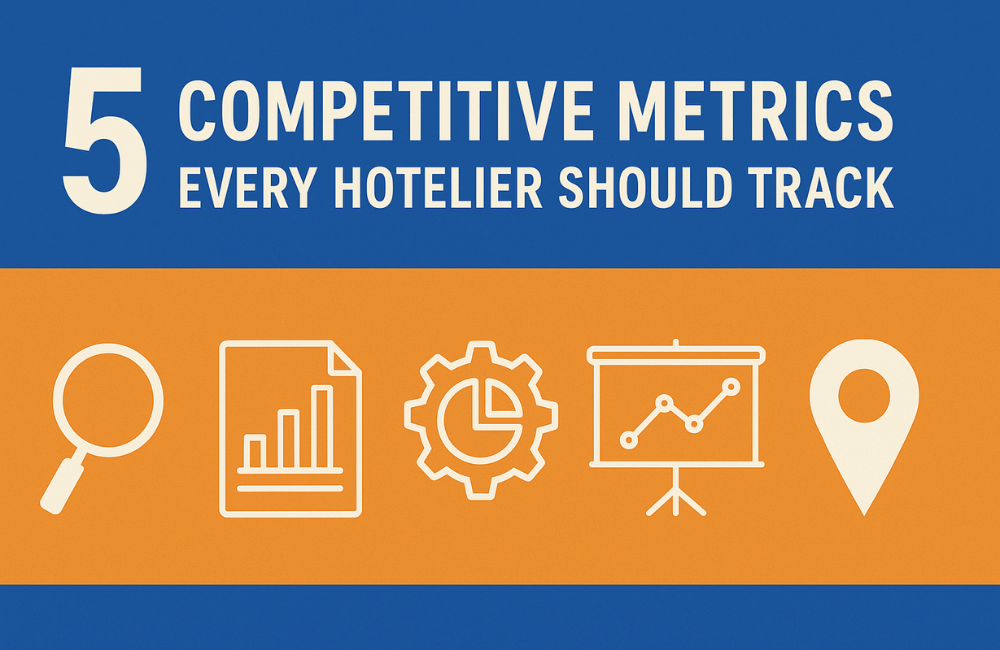5 Competitive Metrics Every Hotelier Should Track

Strong 8k brings an ultra-HD IPTV experience to your living room and your pocket.
In a crowded hospitality market, keeping a close eye on your hotel's competitive performance isn’t optional. It’s essential. While tracking internal KPIs like ADR or occupancy tells you how your hotel is doing, competitive metrics show how well you're doing compared to others. These benchmarks help you adjust rates, spot missed opportunities, and make smarter strategic decisions.
Here are five competitive metrics every hotelier should monitor consistently.
1. Revenue Generation Index (RGI)
What it is
RGI compares your hotel's RevPAR (Revenue Per Available Room) to the average RevPAR of your competitive set.
Why it matters
RGI tells you whether your hotel is capturing its fair share of the market. A score above 1.0 means you're outperforming the competition; below 1.0 means you're leaving money on the table. This is one of the clearest indicators of market positioning in real terms, especially when occupancy and pricing fluctuate seasonally.
How to calculate it
RGI = Your RevPAR / Market RevPAR
Example
If your RevPAR is €180 and your comp set averages €150, your RGI is 1.2. You’re pulling in 20% more room revenue per available room than your competitors.
Actionable insight
Use RGI trends to decide if your rate or occupancy strategy needs adjusting. A rising ADR with a falling RGI might suggest you’ve overpriced yourself.
2. Market Penetration Index (MPI)
What it is
MPI measures how your occupancy stacks up against similar properties in your area.
Why it matters
This metric reveals if you’re attracting more (or fewer) bookings compared to competitors. A higher MPI means you’re dominating your share of demand, while a lower one could signal weak brand visibility, poor marketing, or pricing misalignment.
How to calculate it
MPI = Your Occupancy Rate / Market Occupancy Rate
Example
Your hotel has a 78% occupancy rate. The comp set average is 70%. Your MPI is 1.11 — good news.
Actionable insight
If MPI is falling while occupancy remains stable, it means others are gaining bookings faster than you. Revisit your distribution strategy and review your guest acquisition tactics.
3. Average Rate Index (ARI)
What it is
ARI evaluates how your average daily rate (ADR) compares to your competitors’ ADRs.
Why it matters
This metric answers a key question: Are you pricing competitively? A higher ARI means you're charging more per room than the market average. But if your occupancy suffers as a result, the pricing strategy might be too aggressive.
How to calculate it
ARI = Your ADR / Market ADR
Example
Your ADR is €210. The market ADR is €200. Your ARI is 1.05 — slightly above average.
Actionable insight
Use ARI in tandem with MPI. If ARI is high and MPI is low, your rates may be too steep for your current demand.
4. Gross Operating Profit Per Available Room (GOPPAR)
What it is
GOPPAR goes beyond revenue and looks at profit. It accounts for all hotel income and expenses, divided by available rooms.
Why it matters
GOPPAR reflects the true financial health of your hotel. Even if RevPAR is strong, rising costs can erode profit. This metric helps hoteliers focus on operating efficiency — not just topline revenue.
How to calculate it
GOPPAR = Gross Operating Profit / Total Available Rooms
Example
Let’s say your gross profit is €265,000 for a month and you have 180 rooms. Your GOPPAR is €1,472.22.
Actionable insight
If your GOPPAR lags despite healthy occupancy and ADR, dive into cost centers. Staff productivity, energy usage, and supply chain inefficiencies often hide in the margins.
5. Competitor Price Positioning
What it is
This isn’t a single metric — it’s the practice of tracking how your room rates compare with direct competitors daily, weekly, or seasonally.
Why it matters
Your price positioning determines whether guests see your hotel as a better value, a premium option, or an overpriced choice. Monitoring competitor rates helps you respond quickly to market shifts, flash sales, or upcoming demand spikes. The goal isn’t just to undercut — it’s to price smarter.
How to do it
Use hotel rate shopping tools to gather real-time competitor pricing data. These platforms pull live rates from OTAs, brand websites, and GDSs, making it easy to adjust your strategy before competitors do.
Actionable insight
Are you priced 10% higher than the comp set, but with lower occupancy? You might be losing volume to better-positioned hotels. On the other hand, if you’re consistently underpriced with high occupancy and low RevPAR, you’re leaving revenue on the table.
Tips for Monitoring Competitive Metrics Effectively
Use automated tools: Manual tracking of rates and occupancy trends is no longer sustainable. Consider dynamic dashboards or integrations with your PMS.
Track trends, not just snapshots: A single day of high RGI doesn’t mean success. Watch trends over weeks or months.
Segment your data: Look at metrics by room type, booking channel, or day of week. Averages hide problems.
Benchmark against the right set: Make sure your comp set is realistic. Include hotels with similar location, category, and target audience.
Balance strategy: Pricing higher than the comp set isn’t wrong — if you deliver more value. But the data should justify the position.
Final Thoughts
Success in today’s hotel business isn’t just about running a tight operation — it’s about understanding your position in the market and adjusting quickly. By focusing on competitive performance metrics like RGI, MPI, ARI, GOPPAR, and real-time rate comparison, hoteliers can make better decisions with confidence.
These metrics aren’t static. Review them regularly. Compare them with historical performance. And always think of them as part of a broader strategy that blends pricing, marketing, and operational goals.
Want to outperform your competitors? Start by measuring what truly matters — and keep adjusting.
Note: IndiBlogHub features both user-submitted and editorial content. We do not verify third-party contributions. Read our Disclaimer and Privacy Policyfor details.


